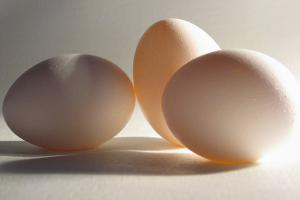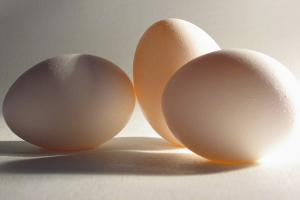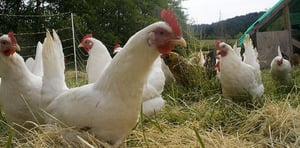Are All Eggs Created Equal?
by JoRushton


Photo courtesy of Brenda Gottsabend under Flickr Creative Commons.
As discerning customers, the majority of us know that buying organic free range, pastured eggs are safer and healthier for us than consuming non-organic, barn laid or worst still cage laid eggs.
We know that organic eggs are superior in nutrient content and typically contain:
- 1/3 less cholesterol
- ¼ less saturated fat
- 2/3 more vitamin A
- 2 times more omega-3 fatty acids
- 3 times more vitamin E
- 7 times more beta carotene
than conventionally produced eggs.
The myth that eggs (as a source of saturated fat) cause increased cholesterol levels and promote heart disease is finally being debunked along with a number of other claims that vindicate animal sources of saturated fats.
If you would like more information on this, Heart of the Matter – a special recently aired on ABC’s Catalyst – confronted many decades of misleading and biased research surrounding this controversial topic. I highly recommend viewing this 2-part program!
One of the major concerns with conventionally produced eggs is the marked increase of omega-6 fatty acids. Organic eggs from hens allowed to feed on insects, worms and green plants, can contain omega-6 and omega-3 fatty acids in the beneficial ratio mother nature intended – approximately one-to-one.
But commercial supermarket eggs can contain as much as nineteen times more omega-6 than omega-3. This is concerning because increased levels of omega-6 can contribute to inflammation in the body due to its pro-inflammatory properties. When the balance of omega-6 to omega-3 is right, that isn’t a problem since omega-3 fatty acids are rich in anti inflammatory properties
But let’s focus on organic eggs. Are some organic eggs healthier and safer for us than others?

Photo courtesy of Woodleywonderworks under Flickr Creative Commons.
The answer is yes depending on what the hens are fed. For example the nutrient content of certified organic hens fed on certified organic grain is not going to be as superior as the certified organic hens that are allowed to feed in open pastures, consuming worms, insects and plant life.
Remember hens, like cows, were not designed to eat grains. They are designed to graze on worms, insects and plant life. So while a certified organic hen is free from GMO feed, and commercial antibiotics and hormones, they may still be eating organic grain such as corn and wheat. This type of feed is exactly what disrupts the omega-3 to omega-6 ratio and alters the nutrient profile of the egg.
The same consideration needs to be taken when sourcing meats. Simply choosing “certified organic” isn’t enough if the cattle are fed on organic grains. Whilst we minimize our exposure to harmful fertilizers, pesticide and fungicides, we are still taking in a saturated fat with increased ratios of omega-6 from grain-based feeds.
It is this altered composition in the animal fat that poses a threat to our health, not the “fat” itself.
With this newfound knowledge, we can appreciate just how important it is to go beyond simply purchasing organic to really question where our food comes from and what processes it’s been through to reach us.
How to eat your eggs for maximum nutrients
- Ideally you want to consume your eggs raw but ONLY if they’re pastured organic, as conventionally raised eggs are more prone to contamination with disease-causing bacteria such as salmonella. Cooking destroys many nutrients. Scrambling your eggs is one of the worst ways to eat eggs as it actually oxidizes the cholesterol in the egg yolk. If you’re not comfortable eating your eggs raw, then soft boiled or soft poached is the next best option.
- Eggs are often one of the most allergenic of foods, but I believe this is because they are cooked. Heating the egg protein actually changes its chemical shape, and these changes can easily lead to allergies. When consumed in their raw state, the incidence of egg allergy can virtually disappear.
- Separating the egg whites from the eggs and consuming only the egg white isn’t the healthier option. Not only do we need the fat contained in the yolk to metabolise the protein of the egg white, but a controlled diet of only raw egg whites can lead to severe biotin deficiency. Why? Because when you consume raw egg white alone, without the yolk, a component in them called avidin binds to the B-vitamin biotin, potentially creating a deficiency in your body.
- Despite what you’ve heard, eggs that are fresh and have an intact cuticle do not need to be refrigerated as long as you are going to consume them within a relatively short period of time.
When all is said and done, an egg isn’t just an egg!
Our continual watchfulness for quality must go beyond assuming that just because a product is organic that it is the best. We need to go one step further and take into consideration where the product comes from, how it has been produced or raised and what processing it has gone through.
5 ways to Check Your Eggs for Freshness and Quality
Regardless of where you get your eggs from, there are several guidelines to ensure that you’re buying and consuming fresh, high-quality eggs:
- Always check the freshness of the egg right before you consume the yolk. If you are at all uncertain about the freshness of an egg, don’t eat it. This is one of the best safeguards against salmonella infection.
- If there is a crack in the shell, don’t eat it. You can easily check for this by immersing the egg in a pan of cool, salted water. If the egg emits a tiny stream of bubbles, don’t consume it as the shell is porous/contains a hole.
- Eggs that are stored in the fridge and opened immediately after taking them out will seem fresher than they actually are. At the very least, eggs should be kept outside of the fridge for at least an hour prior to checking them for freshness or opening them.
- To check for freshness, roll the egg across a flat surface. Only consume it if it rolls wobbly. Alternatively place the egg in a bowl of water if the egg sinks to the bottom, it’s fresh. If the egg sinks to the bottom, but stands on its point, it’s still good but needs to be used soon. If the egg floats to the top, don’t use it.
- Next, open the egg. If the egg white is watery instead of gel-like, don’t consume the egg. If the egg yolk is not convex and firm, don’t consume the egg. If the egg yolk easily bursts, don’t consume the egg.


